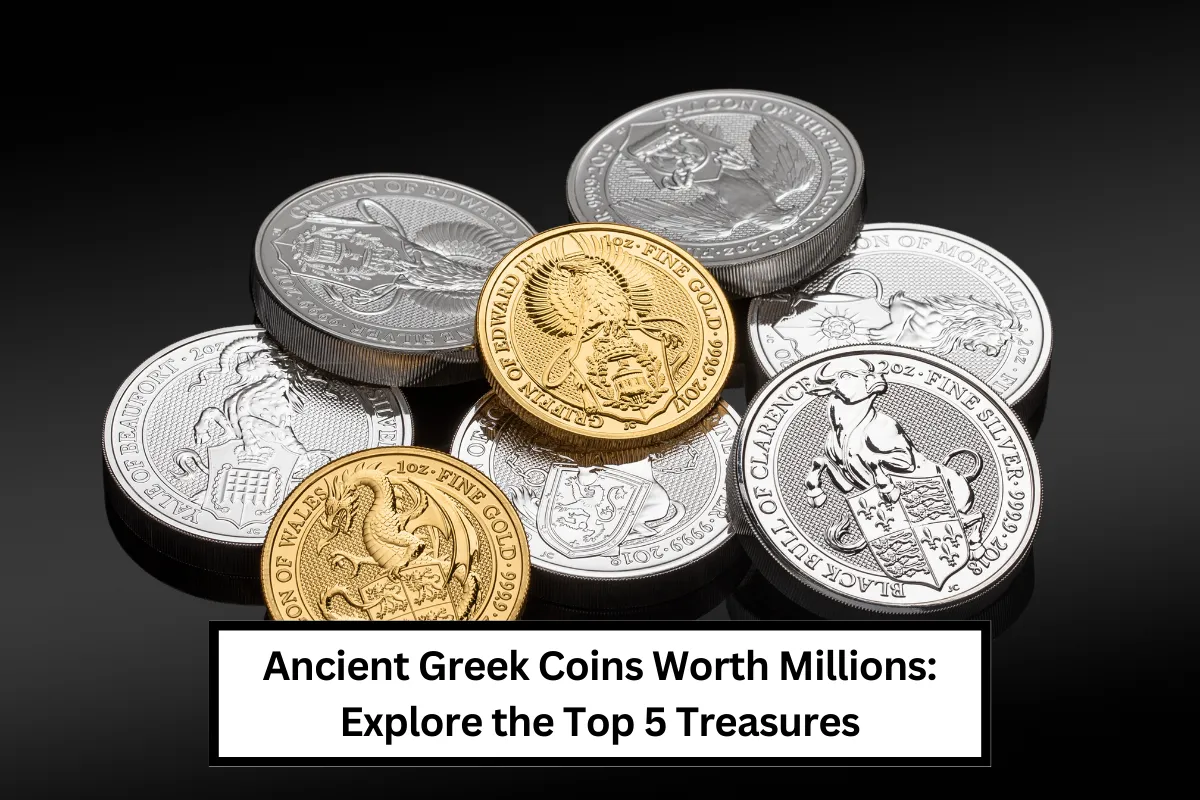Ancient Greek coins are admired for their stunning designs, historical importance, and skilled craftsmanship. These coins often feature rulers, gods, or cities and provide a fascinating glimpse into ancient history.
In this article, we will explore five of the most valuable ancient Greek coins ever discovered, highlighting their unique characteristics and historical significance.
1. Panticapaeum Gold Stater

The Panticapaeum Gold Stater is one of the most valuable ancient Greek coins, recently sold for $6 million at a Swiss auction.
Minted between 340-25 BC in Panticapaeum (modern-day Crimea), this coin features a detailed depiction of a satyr and a griffin.
The satyr, a mythical creature, is shown in a three-quarters left-facing position, adding to its artistic value.
The reverse side depicts a griffin holding a spear, symbolizing power and dominance. Its rarity and excellent condition make it a highly coveted item among collectors.
Coin Details:
- Date Minted: 340-25 BC
- Design: Satyr, Griffin
- Auction Price: $6 million (2023)
2. Akragas Decadrachm
The Akragas Decadrachm, minted in 411 BC in the Sicilian city of Akragas, is another highly valuable coin. This silver coin features the sun god Helios riding a four-horse chariot (quadriga) on the obverse.
The reverse side shows two eagles standing over a hare, representing the sky and sea. The coin was likely minted to commemorate an Olympic chariot race victory. With fewer than ten examples remaining, its value exceeds $2 million.
Coin Details:
- Date Minted: 411 BC
- Design: Helios in a quadriga, eagles
- Auction Price: $2 million+
3. Naxos Tetradrachm

The Naxos Tetradrachm, minted around 460 BC, is notable for its exceptional detail and craftsmanship. This silver coin was created to mark the refounding of Naxos, the oldest Greek colony in Sicily.
The obverse features Dionysus, the god of wine, while the reverse depicts the satyr Silenos. Its artistic value and historical relevance contribute to its estimated worth of approximately $1.5 million in private sales.
Coin Details:
- Date Minted: 460 BC
- Design: Dionysus, Silenos
- Auction Price: $1.5 million
4. Athens Tetradrachm (Owl Coin)
The Athens Tetradrachm, also known as the Owl coin, is one of the most iconic ancient Greek coins. Minted around 454 BC, this silver coin was widely circulated throughout the Mediterranean.
The obverse features the goddess Athena, while the reverse shows an owl, a symbol of wisdom.
Although more common than some other coins on this list, high-quality examples of the Owl coin have sold for upwards of $500,000 due to their cultural significance and role in ancient trade.
Coin Details:
- Date Minted: 454 BC
- Design: Athena, Owl
- Auction Price: $500,000+
5. Gold Stater of Croesus
The Gold Stater of Croesus, minted in 550 BC by King Croesus of Lydia (modern-day Turkey), is recognized as the world’s first pure gold coin. The coin features a lion and a bull on its obverse, symbolizing strength and power.
Croesus’ introduction of pure gold and silver coinage was a significant development in ancient monetary systems. Today, a Gold Stater of Croesus can fetch over $1 million due to its historical importance.
Coin Details:
- Date Minted: 550 BC
- Design: Lion, Bull
- Auction Price: $1 million+
These ancient Greek coins not only represent remarkable artistry and historical significance but also hold immense value for collectors and historians. From the Panticapaeum Gold Stater to the Gold Stater of Croesus,
each coin tells a unique story of the ancient world, reflecting the richness of Greek culture and history. Their continued fascination and high auction prices underscore their importance as historical artifacts.
1. What makes ancient Greek coins so valuable?
Ancient Greek coins are valuable because of their historical significance, artistic design, and rarity. Many of these coins were minted by powerful rulers or cities and often feature intricate details and symbols from ancient Greek mythology. Their limited availability and the historical context in which they were created add to their value.
2. Why is the Panticapaeum Gold Stater worth so much?
The Panticapaeum Gold Stater is worth a staggering amount due to its rarity, excellent condition, and historical importance. Minted between 340-25 BC, it features detailed depictions of a satyr and a griffin, and it sold for $6 million because it is a highly sought-after artifact among collectors and historians.
3. How many Akragas Decadrachms are left?
There are fewer than ten known examples of the Akragas Decadrachm remaining. Its rarity, combined with its historical significance as a coin likely minted to celebrate an Olympic chariot race victory, contributes to its value of over $2 million.
4. What does the Athens Tetradrachm (Owl Coin) symbolize?
The Athens Tetradrachm, also known as the Owl coin, features the goddess Athena on one side and an owl on the reverse. The owl symbolizes wisdom, and the coin was widely circulated throughout the Mediterranean. Its cultural and historical significance makes high-quality examples highly valuable, sometimes selling for over $500,000.
5. Why is the Gold Stater of Croesus historically important?
The Gold Stater of Croesus is historically important because it was the world’s first pure gold coin, minted in 550 BC. This coin marked a significant development in ancient monetary systems, introducing pure gold and silver coinage. Its pioneering role in currency history contributes to its value, which can exceed $1 million at auctions.










